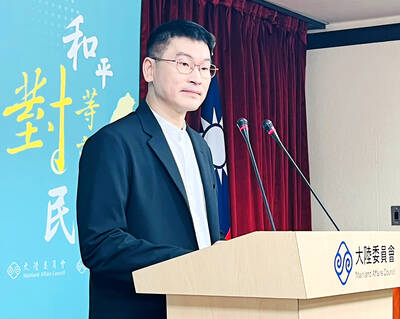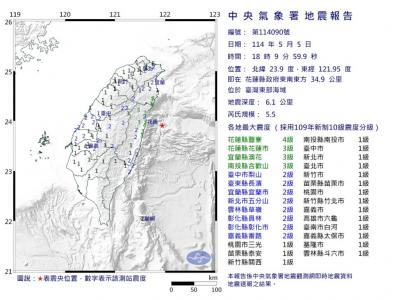The nation’s voters will go to the polls tomorrow to elect mayors, councilors and ward chiefs in elections which are local in nature, but pivotal in significance.
According to the Central Election Commission, more than 10.6 million people are eligible to vote in five existing or soon-to-be--created special municipalities under the direct jurisdiction of the central government.
Although these elections will not result in a transfer of power on the national level, they are being closely watched because they involve constituencies with 13.7 million people, or 60 percent of Taiwan’s total population, and their outcome is likely to have profound implications for the country’s political development.

PHOTO: CNA
Both the Chinese Nationalist Party (KMT) and the Democratic Progressive Party (DPP) have campaigned aggressively to try to win the five mayoral seats up for grabs.
At present, the KMT holds power in Taipei and Taipei County (which will be renamed Sinbei City after its upgrade next month) and the county-level administrative districts (Taichung and Taichung County) that will form the newly Greater Taichung.
The DPP has control of Tainan and Tainan County, which will be merged to form Greater Tainan, and Kaohsiung and Kaohsiung County, which together will become Greater Kaohsiung.
One of the most intensely watched races has been the Taipei mayoral election.
After former Taipei mayors Chen Shui-bian (陳水扁) and Ma Ying-jeou (馬英九) moved on to become president in 2000 and 2008 respectively, the post has been widely seen as a stepping stone to the presidency.
Controlled by the KMT for the past 12 years, Taipei is considered a stronghold of the pan-blue camp.
Taipei Mayor Hau Lung-bin (郝龍斌) is running against a strong challenge from Su Tseng-chang (蘇貞昌), a former premier and DPP chairman. Three independent candidates are also running, but are expected to have little impact.
In Taipei’s four previous mayoral elections, no DPP candidate has ever gained more than 50 percent of the vote. Chen had the best showing when he lost his bid for re-election in 1998 to Ma with 45.9 percent of the vote, compared with Ma’s 51.1 percent. Chen won the 1994 election with 43.7 percent of the vote because of a split in the KMT camp.
Su hopes to expand his party’s support base in the city and break the KMT’s dominance in a race seen as being neck-and-neck.
In Taipei County, with a population of 3.89 million, the race is also being closely observed.
The race pits KMT candidate Eric Chu (朱立倫) against DPP Chairperson Tsai Ing-wen (蔡英文), both of whom are considered their parties’ best possible candidates for this key battleground.
In central Taiwan, DPP candidate Su Jia-chyuan (蘇嘉全) seems to be fighting an uphill battle against Taichung Mayor Jason Hu (胡志強).
Both Taichung and Taichung County have been held by the KMT since 1989, except between 1997 and 2001.
Su Jia-chyuan, a two-term Pingtung County commissioner and a former minister of agriculture, has pushed his candidacy hard in Taichung County, where agricultural issues are important, hoping to use it to offset Hu’s advantage in the city.
The mayoral race in Greater Tainan, a DPP stronghold with a combined population of more than 2.7 million, has received less media attention because it is widely seen as a shoo-in for the DPP.
In Greater Kaohsiung, Kaohsiung County Commissioner Yang Chiu-hsing’s (楊秋興) withdrawal from the DPP to run as an independent has turned the race into a three-way contest with DPP Kaohsiung Mayor Chen Chu (陳菊) and KMT Legislator Huang Chao-shun (黃昭順).
The Greater Kaohsiung area is also considered a DPP stronghold, although its advantage in the past has been in Kaohsiung County, with voters in Kaohsiung more evenly divided.

An essay competition jointly organized by a local writing society and a publisher affiliated with the Chinese Communist Party (CCP) might have contravened the Act Governing Relations Between the People of the Taiwan Area and the Mainland Area (臺灣地區與大陸地區人民關係條例), the Mainland Affairs Council (MAC) said on Thursday. “In this case, the partner organization is clearly an agency under the CCP’s Fujian Provincial Committee,” MAC Deputy Minister and spokesperson Liang Wen-chieh (梁文傑) said at a news briefing in Taipei. “It also involves bringing Taiwanese students to China with all-expenses-paid arrangements to attend award ceremonies and camps,” Liang said. Those two “characteristics” are typically sufficient

A magnitude 5.9 earthquake that struck about 33km off the coast of Hualien City was the "main shock" in a series of quakes in the area, with aftershocks expected over the next three days, the Central Weather Administration (CWA) said yesterday. Prior to the magnitude 5.9 quake shaking most of Taiwan at 6:53pm yesterday, six other earthquakes stronger than a magnitude of 4, starting with a magnitude 5.5 quake at 6:09pm, occurred in the area. CWA Seismological Center Director Wu Chien-fu (吳健富) confirmed that the quakes were all part of the same series and that the magnitude 5.5 temblor was

The brilliant blue waters, thick foliage and bucolic atmosphere on this seemingly idyllic archipelago deep in the Pacific Ocean belie the key role it now plays in a titanic geopolitical struggle. Palau is again on the front line as China, and the US and its allies prepare their forces in an intensifying contest for control over the Asia-Pacific region. The democratic nation of just 17,000 people hosts US-controlled airstrips and soon-to-be-completed radar installations that the US military describes as “critical” to monitoring vast swathes of water and airspace. It is also a key piece of the second island chain, a string of

The Central Weather Administration has issued a heat alert for southeastern Taiwan, warning of temperatures as high as 36°C today, while alerting some coastal areas of strong winds later in the day. Kaohsiung’s Neimen District (內門) and Pingtung County’s Neipu Township (內埔) are under an orange heat alert, which warns of temperatures as high as 36°C for three consecutive days, the CWA said, citing southwest winds. The heat would also extend to Tainan’s Nansi (楠西) and Yujing (玉井) districts, as well as Pingtung’s Gaoshu (高樹), Yanpu (鹽埔) and Majia (瑪家) townships, it said, forecasting highs of up to 36°C in those areas